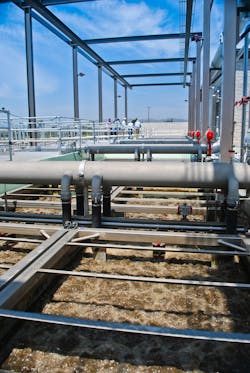The city of Santa Paula, Calif., recently completed construction of the first water recycling facility built under California Government Code 5956 to encourage private investment aiding in solving public infrastructure needs.
The city selected the PERC Water/Alinda Capital team to design, build, operate and finance a 7.2-million-galper-day (mgd) peak daily flow membrane bioreactor (MBR) facility that will allow it to meet current and future wastewater treatment needs while complying with environmental standards. Santa Paula also expects the new facility to enable the use of recycled wastewater for irrigation.
Santa Paula chose MBR technology because it combines biological wastewater treatment and membrane filtration into a one-unit process, producing consistently high-quality effluent in a compact footprint. PERC Water selected the single-header Puron membrane filtration modules from Koch Membrane Systems to incorporate into the MBR design because they are energy efficient and provide low lifecycle costs. The Santa Paula project is the first large MBR installation in North America to use the Puron membrane filtration modules.
Fines for Facility
Santa Paula is located 65 miles northwest of Los Angeles in the rich agricultural Santa Clara River Valley. Surrounded by rolling hills, rugged mountain peaks, and orange, lemon and avocado groves, the city sometimes is called the “Citrus Capital of the World.”
Santa Paula’s wastewater treatment facility was constructed in 1939 and today serves about 30,000 residents. Hindered by failing infrastructure and dated technology, the facility was in violation of several discharge requirements issued by the Los Angeles Regional Water Quality Control Board (RWQCB) and had received more than 3,000 violations and fines in excess of $8 million. To comply with the increasingly stringent regulations, the city made several plant modifications, but it ultimately failed to achieve the operating requirements.
A consent judgment with the state issued in 2007 allowed the city to apply the fines toward a new wastewater treatment plant if the facility was completed and in compliant operation by Dec. 15, 2010. Santa Paula opted to pursue a design-build-operate-finance strategy to construct a new state-ofthe- art water recycling facility designed to meet the city’s current and future wastewater treatment needs.
The project was awarded to Santa Paula Water, a partnership of PERC Water and Alinda Capital, in May 2008.
The new facility is designed for a 7.2- mgd peak daily flow (10.4-mgd peak hour) and a 3.4-mgd average daily flow capacity with the ability to expand to 4.2 mgd. The system was completed and in full operation in May 2010, seven months ahead of deadline.
MBR Technology
After a thorough assessment of the facility needs, Santa Paula Water chose MBR technology to provide an advanced treatment process, increase plant capacity and reuse water for irrigation. MBR systems increasingly are used in locations where water resources are scarce, reusable quality effluent is desirable, space availability is limited and stringent discharge standards are in effect. These locations may include small communities, housing developments, commercial developments, resorts, hotels, malls, schools and golf courses. The MBR also is employed for industrial applications to recycle process water and reduce wastewater disposal costs and water footprints.
The Santa Paula MBR facility has a compact design, with fully redundant headworks, a conservative and efficient aeration design, a biological foam spray system and hollow-fiber membranes with incorporated aeration. Effluent from the system will discharge into evaporation/percolation ponds, and a portion of the water eventually will be used for irrigation.
The new water recycling facility is designed to produce an effluent that meets or exceeds all current environmental wastewater quality standards mandated by the U.S. Environmental Protection Agency and the RWQCB. The MBR is designed to produce a finished effluent with biochemical oxygen demand and total suspended solids (TSS) concentrations of less than 5 mg/L, total nitrogen less than 8 mg/L and turbidity less than 0.2 NTU.
Design & Features
An MBR is a biological process that combines secondary and tertiary treatment using a membrane filtration process. Because membranes are used to provide the necessary solids-liquid separation, MBR effluent is consistently high quality with low turbidity, low bacterial counts and low TSS and NTU counts. The filtrate quality, in many instances, is suitable for feeding directly into a reverse osmosis (RO) process, if required.
An additional advantage of an MBR system is its compact footprint. This is achieved by replacing the secondary clarification process with membrane separation and by operating the biological process with higher mixed-liquor suspended solids than conventional activated sludge systems. Despite its advantages, using membranes for solids liquid separation requires careful assessment of several critical design elements.
PERC Water turned to Puron membrane modules as a cost-effective and energy-efficient solution to meet the RWQCB’s stringent discharge requirements. The membrane modules produce high-quality effluent that meets water reuse and recycling requirements while significantly reducing the treatment system footprint, installation cost and manpower commitment—all key requirements for the Santa Paula site. Because membrane scouring and biological aeration account for nearly half of the Santa Paula facility’s power consumption, PERC Water installed 24 PSH-1500 modules, making it one of the largest MBR installations in North America.
Puron modules are energy efficient, with the lowest energy demand of all commercially available MBR modules. The system is easy to operate with features designed to provide significantly lower life-cycle costs, including a single header design that provides better solids management in the module, braided fibers to reduce the risk of fiber breakage and highly effective air scouring that virtually eliminates sludging. An important advantage of the patented module is the use of a single header with reinforced hollow fibers that are fixed only at the bottom. The sealed upper end of the fiber is allowed to float freely. The freefloating tip design eliminates buildup of hair and fibrous materials that typically clog the upper ends of membrane fibers in MBR module designs that employ both top and bottom headers.
Solids and particulates, including bacteria, are retained by the membrane and remain on the outside while permeate is drawn through the membrane to the inside of the fibers. The outside-toinside flow pattern provides optimal solids management and a high flow rate.
The Santa Paula facility includes the larger 1,500-sq-meter module, which simplifies design, operation and retrofit of large-scale MBR plants. The improved submerged membrane module features greater packing density, lower energy costs for aeration and simplified installation, while providing improved compatibility with other commercially available systems. Features such as an optimized permeate extraction manifold and air supply lines reduce the number of piping connections during installation. For additional flexibility, the new product line enables users to retrofit the advanced Puron technology into systems with comparably sized modules.
To simplify membrane cleaning and maintenance, the central aeration system and the bottom header have been redesigned. The new aeration system reduces the flow rate during air scouring, resulting in a decrease in air usage by up to 20% more than the original design. PERC Water’s design uses 5 acres less land than would be required by a conventional wastewater treatment facility. The plan includes a recycling education center, where local students can learn how water recycling facilities function.
Power Performance
In its first few months of operation, the plant’s power consumption was 4.4 kWh per 1,000 gal treated. This consumption is based on power used by all processes throughout the facility, including digestion, building power, the MBR process, ultraviolet system and RO. As flows increase, it is expected that the power consumption per thousand gallons will decrease further.
With the equipment selected for this facility, Santa Paula’s MBR promises to be one of the most energy-efficient MBR installations in the world.
Download: Here


